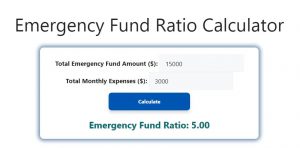About Emergency Fund Ratio Calculator (Formula)
An Emergency Fund Ratio Calculator is a vital tool for evaluating your financial resilience in the face of emergencies. It helps determine how well you are prepared to handle unforeseen events, such as medical emergencies, job loss, or major repairs, by comparing your liquid assets to your monthly expenses. A good emergency fund provides financial security during tough times, and this calculator helps you assess whether you have enough savings.
Formula
The formula for calculating the emergency fund ratio is:
Emergency Fund Ratio = Total Liquid Assets / Monthly Expenses
Where:
- Total Liquid Assets refer to cash or assets that can be easily converted into cash, such as savings, checking accounts, or money market accounts.
- Monthly Expenses include your regular recurring expenses, such as rent, utilities, groceries, and transportation costs.
How to Use
- Determine Your Liquid Assets: Add up the value of all your cash and easily accessible assets.
- Calculate Monthly Expenses: Sum up your regular expenses like rent, groceries, and bills to get a monthly total.
- Apply the Formula: Divide your total liquid assets by your monthly expenses to get the emergency fund ratio.
- Interpret the Result: A ratio of 3 to 6 months is typically recommended as a healthy emergency fund.
Example
Suppose you have $15,000 in liquid assets and your monthly expenses amount to $3,000.
Emergency Fund Ratio = $15,000 / $3,000 = 5
This means you have 5 months’ worth of expenses saved, which is a solid emergency fund.

FAQs
- What is an Emergency Fund Ratio Calculator?
An Emergency Fund Ratio Calculator helps you determine how many months of living expenses your liquid assets can cover in the event of an emergency. - Why is the emergency fund ratio important?
It assesses your financial preparedness, indicating how long you can sustain your expenses without income during emergencies. - What is considered a healthy emergency fund ratio?
A healthy emergency fund ratio typically ranges from 3 to 6 months of living expenses. - What qualifies as liquid assets?
Liquid assets include cash, checking and savings accounts, money market accounts, and short-term investments that can easily be converted to cash. - What should I include in monthly expenses?
Include essential expenses like rent/mortgage, utilities, groceries, transportation, insurance, and debt payments. - Can I include investments in liquid assets?
Only include investments that can be easily converted to cash without penalties, such as money market funds or savings bonds. - How do I increase my emergency fund ratio?
Increase your savings, cut unnecessary expenses, and aim to consistently contribute to your emergency fund. - Is an emergency fund the same as savings?
An emergency fund is a portion of your savings set aside specifically for unexpected expenses. - Can I use my emergency fund for planned expenses?
No, the emergency fund is meant only for unplanned expenses like job loss, medical emergencies, or major repairs. - What happens if my emergency fund ratio is too low?
If your ratio is too low, it means you may not have enough savings to cover unexpected expenses, putting you at financial risk. - Is a higher emergency fund ratio better?
Yes, a higher ratio indicates better financial preparedness, but be cautious of over-saving at the expense of other financial goals. - What should I do if I have no emergency fund?
Start building your emergency fund by saving a small amount regularly and cutting non-essential expenses until you reach a healthy ratio. - Should I include credit in my emergency fund?
No, credit should not be considered part of your emergency fund, as it is borrowed money and can lead to debt. - How often should I review my emergency fund ratio?
Review your ratio annually or whenever there’s a significant change in your financial situation, such as a change in income or expenses. - Can I use an emergency fund for a down payment on a house?
No, your emergency fund should not be used for planned expenses like a down payment. It’s reserved for unforeseen events. - What happens if I deplete my emergency fund?
If you deplete your emergency fund, prioritize rebuilding it once the emergency is resolved. - Can I invest my emergency fund?
It is not advisable to invest your emergency fund in volatile assets. Keep it in liquid, low-risk accounts for easy access. - How does having an emergency fund affect financial stress?
Having a solid emergency fund can significantly reduce financial stress, giving you peace of mind in the face of unexpected expenses. - Should I use my emergency fund to pay off debt?
It’s best to balance saving for emergencies and paying off debt. You don’t want to deplete your fund completely to pay off debt. - Is it possible to save too much in an emergency fund?
Yes, saving excessively in an emergency fund might prevent you from investing in other long-term goals like retirement or education.
Conclusion
An Emergency Fund Ratio Calculator is an excellent tool for evaluating your financial readiness to handle unforeseen situations. By knowing your ratio, you can ensure you have enough savings to cover several months of expenses, giving you a safety net during tough times. It’s crucial to maintain a healthy emergency fund ratio and adjust it periodically based on your financial situation and needs.